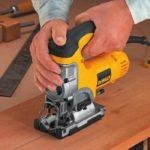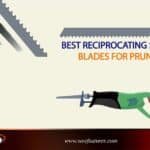If you are a regular chainsaw user, you must be familiar with the term "chainsaw kickback." You know how's it feels to experience the moment when your chain is delivering a backward momentum.
For an inexperienced cutter, this is like their daily breakfast. But it's not something unavoidable like death. You know, there's a saying, "you're either part of the solution or you are part of the problem." So, yeah, also, the solution to this problem is in your hand.
All it takes here is just to know the basic principle of chainsaw and a chunk of practice. In this article, we will discuss, what is chainsaw kickback, and what we can do to avoid it.
What is Chainsaw Kickback?
First and foremost, to solve a problem, you need to know the problem. So, let's get to know what is chainsaw kickback. Is this some kind of special kick in football or something else?
Well, let me explain; what we can understand by "kickback" is its sudden, upward motion of your chainsaw's guide bar. It happens when the ending part of the chainsaws nose bar, known as the kickback zone, hits an object and resulting, in the chain getting snagged or pinched momentarily.
There are 2 types of kickbacks:
- Linear kickback (do not pinch the chain)
- Rotational kickback (occurs in wood)
Trust me when I say this happens to almost every a cordless electric chainsaws or gas chainsaw user out there and causes an accident. But it can be easily avoided just by following some simple guidelines. We will have a broad discussion down below.
What Causes Chainsaw Kickback?
Chainsaw kickback could happen for various reasons, especially when you are dumb enough to hit any materials with the slide bar. But it may also occur to some saw users when they become too uncomfortable with using the saw. At the top front of the chain, the kickback zone area is prone to kickbacks.
It can also occur when your bar and the chain get pinched during the cutting process. When you are bucking timber into the logs on a bumpy surface, this may occur often.
At times the chain may get suddenly halted and, when that happens, the moving force of the chain is bound to travel somewhere; as a result, the momentum gets transferred. This will force the saw to pivot upward and backward to you, and that's you are experiencing the rotational kickback.
Usually, it happens when the cutter of a chain becomes vulnerable to the big piece of wood as it crossed the top quadrant of the saw's guide bar's tip or, sometimes, when it touches any foreign object.
at a glance, we find one or in combination following factors can build the chainsaw kickback risk:
- Improper saw maintenance
- Ordinary chain or Loose saw chain tension
- Incorrectly installed chain parts
- Loose rivets, Bent, cracked, or damaged saw chain components
- Wrong sharpened chain angles
- Excessive chain depth gauge settings
- Incorrect chain depth gauge shapes
- Finally Guide Bar Nose Size - The larger the guide bar nose, the greater the risk
The Kickback Zone
That's an important part of your chainsaw known as the "kickback zone." It's situated at the tip of your chainsaw bar. You might be wondering why it's named the kickback zone.
Well, the reason is this part of the chainsaw plays the most significant role in causing kickback.

So, it's better if you always avoid this part of the chainsaw when cutting any objects. Otherwise, you will have to deal with kickbacks.
If the edge of your chainsaw bar comes in contact with any object, such as a log or branch, you can't avoid the kickback.
How to Reduce Chainsaw Kickback?
We hope now you understand what is chainsaw kickback and the reasons why it happens. Now, let's talk about the solutions. What can we do to prevent this from happening? Here are some quick tips:
Read the Manual
Before starting with your chainsaw, we would highly advise you to read the user manuals carefully and entirely. Don't stay inside of that bubble that every chainsaw works in the same way. Taught yourself the appropriate methods of handling the saw.
Be Careful with the Nose Bar
When removing tree branches, you got to be a bit extra-cautious. If your saws nose bar comes in contact with any objects like stumps, logs, or hidden branches, this may cause a kickback.
Maintain a Safe Height
Avoid using the chainsaw above the height of your shoulder. You won't have rigid and confident control over the chainsaw and, in such a case, you will have a hard time dealing with any sudden backward thrust of the blade.
Apply a Bucking Spike
When you are crosscutting wood or felling a tree, bore the base of your chainsaw into the log or trunk. You may also try using a bucking spike, this will help you to prevent sudden kickbacks.
Wear Protective Gear
Don't forget to wear the proper protective gear and equipment when using the chainsaw. For instance, wearing, protective goggles, chainsaw chaps, gloves, helmet (if there's a high-risk), heavy-duty work boot, and earmuffs.
More tips for Reduce Chainsaw Kickback?
Be Confident: Hold the chainsaw confidently, wrapping your fingers tightly around the handle.
Be Focused: Stay alert and awake when you are using the saw. If you are feeling very tired, sleepy, or fatigued please, do avoid using the chainsaw.
Do a Double Check: You might want to double-check the chain brake whether it's functioning properly, or not before you kick off the cutting procedure.
Avoid Using the Tip: Never use the tip of your chainsaw to cut. Otherwise, you will have to meet the issue called kickback.
Be Careful with Positioning: Have a clear idea about the position of your chainsaws nose and how it's placed.
Use Low Kickback Chain: Using any chainsaw with a low kickback chain will reduce the possibility of kickback.
Avoid Using the Top Bar: When cutting down any tree, you need to use the bottom side of the bar, avoid using the top of the bar.
Be Serious with the Guideline: Take the use-guidelines seriously and keep all the instructions in your mind when using the chainsaw.
Keep Your Kids Away: Keep any kids away from your working area when using the chainsaw.
What is Low-Kickback Chain?
Most of today's chainsaw some built-in features for reducing kickback and other sources of chainsaw-related injury. Include chain brakes, the front (left) hand guard, the bar tip guard, and low or reduced kickback chain and guide bars.
Apart from this, you will find some chains in the market that come with some extra advantages for avoiding kickbacks. All the saws under 66cc engine displacement offer a low kickback chain setup.
Yeah, you can replace almost all kinds of chains independently though we wouldn't recommend it.
The sort of chain works by reducing the amount of fiber tends to catch up on the bar when it moves to the kickback zone. You have different options for this but, the most familiar way is adding an extra amount of metal between the cutters.
If you are a newbie or have not any training, you should use a low kickback chain on your chainsaw. You find so many low kickback chains in the market that are packaged with a green label from the American National Standards Institute (ANSI).
Final Words
As you are well-aware of what is chainsaw kickback, how it works, and what you can do to prevent it. So you are not supposed to have many issues when using your chainsaw next time. We would like to remind you again about reading the user-manual seriously.
You must know that not all the chainsaw out there follows the same operating method. So, before getting started with a new one, it's wise to read its manual first. We wish you good luck with your chainsaw.









